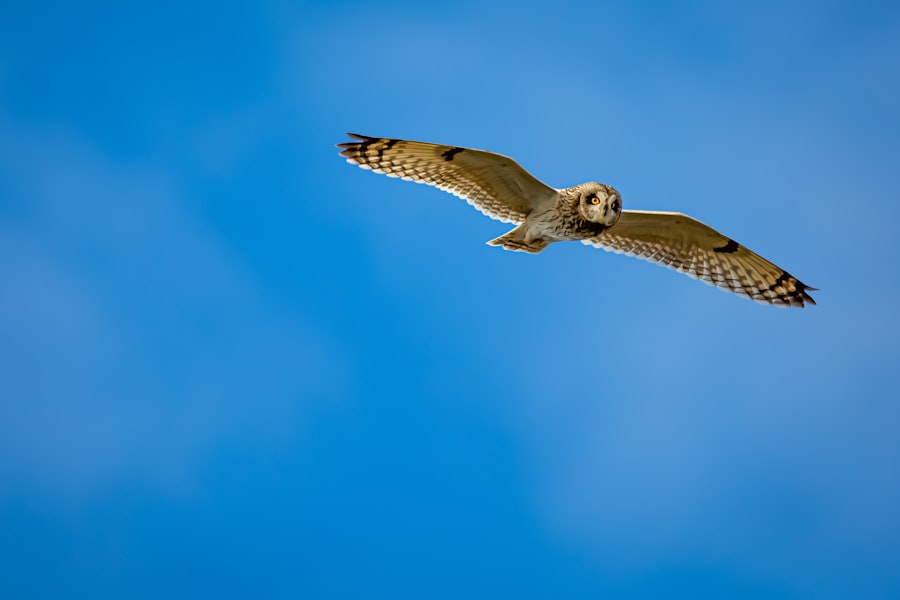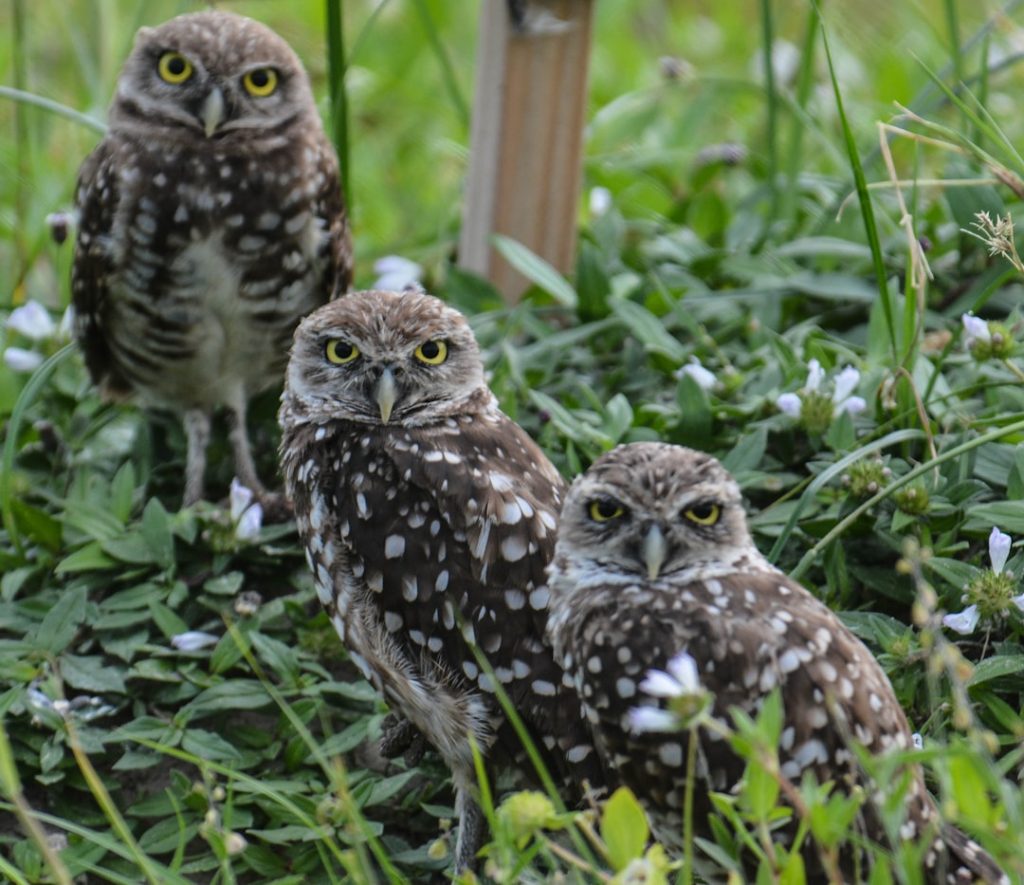Owls are natural predators of chickens and pose a significant threat to poultry flocks. These nocturnal birds of prey possess exceptional eyesight and sharp talons, making them efficient hunters. Owls typically attack chickens at night when the birds are most vulnerable and can swiftly carry off their prey.
Understanding owl behavior is crucial for implementing effective protection strategies. Owls are known for their silent flight, which allows them to approach chickens undetected. Their powerful talons can easily injure or kill a chicken with a single strike.
Owls’ stealthy hunting techniques make it difficult for chickens to detect their presence until it’s too late. To safeguard chickens from owl attacks, it is essential to secure the coop and implement deterrent measures. This may include installing proper fencing, using motion-activated lights, and employing scare tactics to discourage owls from approaching the flock.
By recognizing the threat owls pose and taking proactive steps, chicken owners can create a safer environment for their poultry.
Table of Contents
- 1 Securing the chicken coop
- 2 Implementing scare tactics
- 3 Utilizing owl deterrents
- 4 Creating a safe environment for chickens
- 5 Monitoring owl activity
- 6 Seeking professional help
- 7 FAQs
- 7.1 What are the potential threats owls pose to chickens?
- 7.2 What are some effective methods to keep owls away from chickens?
- 7.3 Are there any natural deterrents that can be used to keep owls away from chickens?
- 7.4 What are some additional measures that can be taken to protect chickens from owls?
- 7.5 Are there any legal considerations when it comes to protecting chickens from owls?
Key Takeaways
- Owls pose a significant threat to chickens, especially at night when they are most active.
- Securing the chicken coop with sturdy fencing and locks can help prevent owl attacks.
- Implementing scare tactics such as noise makers and motion-activated lights can deter owls from approaching the coop.
- Utilizing owl deterrents like decoy owls or reflective tape can help keep real owls away from the chickens.
- Creating a safe environment for chickens by providing adequate shelter and roosting spots can help protect them from owl attacks.
- Monitoring owl activity around the coop can help identify patterns and adjust deterrent strategies accordingly.
- Seeking professional help from wildlife experts or pest control services may be necessary for persistent owl threats.
Securing the chicken coop
Inspect and Secure the Coop
One of the most effective ways to protect your chickens from owl attacks is by securing the chicken coop. This involves ensuring that the coop is well-constructed and free from any potential entry points for owls. Start by inspecting the coop for any gaps, holes, or openings that could allow owls to gain access. Seal off any openings with sturdy wire mesh or hardware cloth to prevent owls from entering the coop.
Reinforce the Coop’s Structure
It’s also important to reinforce the roof of the coop to prevent owls from swooping down and grabbing chickens from above. Use strong and durable materials to build the coop, such as heavy-duty wood or metal, to make it more difficult for owls to break in.
Strategic Coop Placement
In addition to securing the physical structure of the coop, it’s important to consider the placement of the coop within your property. Avoid placing the coop in open areas where owls have easy access and visibility. Instead, position the coop in a more sheltered location, such as near trees or buildings, to provide some natural cover and protection from owl attacks.
By securing the chicken coop and strategically placing it within your property, you can significantly reduce the risk of owl attacks and create a safer environment for your chickens.
Implementing scare tactics

Implementing scare tactics is another effective way to deter owls from targeting your chickens. Owls are intelligent birds and can be deterred by various visual and auditory stimuli that signal danger or discomfort. One common scare tactic is to use predator decoys, such as fake owls or hawks, to create the illusion of a threat in the area.
Place these decoys near the chicken coop or in areas where owls are known to frequent to discourage them from approaching. It’s important to regularly move the decoys around to prevent owls from becoming accustomed to their presence. Another effective scare tactic is to install motion-activated lights or sound devices near the chicken coop.
These devices can startle owls and deter them from approaching when they detect movement or sound. Additionally, hanging shiny objects, such as aluminum foil strips or CDs, around the coop can create visual disturbances that make owls uncomfortable and less likely to linger in the area. By implementing scare tactics, you can disrupt the hunting patterns of owls and reduce the likelihood of them targeting your chickens.
Utilizing owl deterrents
In addition to scare tactics, there are specific deterrents that can be used to discourage owls from targeting your chickens. One effective deterrent is the use of netting or wire mesh to cover outdoor areas where chickens roam during the day. This can prevent owls from swooping down and grabbing chickens while they are outside of the coop.
Make sure that the netting or wire mesh is securely fastened and extends over a wide area to provide adequate protection for your chickens. Another owl deterrent is the use of noise-making devices, such as air horns or whistles, that can be activated when an owl is spotted in the vicinity of the chicken coop. The loud and sudden noises can startle owls and discourage them from approaching, especially if they associate the noise with a potential threat.
It’s important to use these devices sparingly and strategically to avoid causing unnecessary stress to your chickens.
Creating a safe environment for chickens
Creating a safe environment for your chickens goes beyond just protecting them from owl attacks. It also involves providing adequate shelter, food, water, and space for them to thrive. Ensure that the chicken coop is clean, well-ventilated, and equipped with roosting bars and nesting boxes for your chickens to rest and lay eggs.
Regularly clean and maintain the coop to prevent the buildup of waste and potential health hazards for your flock. Provide a balanced diet for your chickens that includes a mix of grains, seeds, fruits, vegetables, and protein sources such as insects or mealworms. Access to clean water is also essential for keeping your chickens healthy and hydrated.
Additionally, allow your chickens access to outdoor areas where they can roam, scratch for food, and engage in natural behaviors. Creating a safe and enriching environment for your chickens can help them feel secure and reduce their vulnerability to owl attacks.
Monitoring owl activity

Identifying Owl Presence
Regularly monitoring owl activity in your area can provide valuable insights into their behavior and help you identify potential threats to your chickens. Keep an eye out for signs of owl presence, such as owl pellets, feathers, or droppings near the chicken coop or in surrounding areas. These indicators can help you determine if owls are actively hunting in your vicinity and allow you to take proactive measures to protect your flock.
Using Technology to Track Owl Movements
You can also use trail cameras or motion-activated wildlife cameras to capture footage of owls in the area and track their movements. This can help you understand their hunting patterns and identify any potential vulnerabilities in your chicken coop or property that may attract owls.
Staying Ahead of Owl Threats
By monitoring owl activity, you can stay one step ahead and implement targeted strategies to keep your chickens safe from potential threats.
Seeking professional help
If you’re facing persistent owl predation on your chickens despite implementing various deterrents and protective measures, it may be time to seek professional help. Contacting a local wildlife conservation organization or bird control expert can provide you with valuable guidance and assistance in managing owl predation on your property. These professionals can offer expert advice on owl behavior, habitat management, and non-lethal control methods that are safe for both owls and chickens.
In some cases, obtaining a permit for humane trapping and relocation of problematic owls may be necessary to protect your flock. However, it’s important to consult with wildlife authorities and follow legal regulations regarding owl management in your area. Seeking professional help can provide you with access to resources and expertise that can help you effectively address owl predation while ensuring the well-being of both owls and chickens.
In conclusion, protecting your chickens from owl predation requires a combination of understanding the threat, securing the chicken coop, implementing scare tactics, utilizing owl deterrents, creating a safe environment for chickens, monitoring owl activity, and seeking professional help when needed. By taking proactive measures and staying informed about owl behavior and management strategies, you can create a safer environment for your flock and reduce their vulnerability to owl attacks. With careful planning and diligence, you can successfully protect your chickens from potential threats posed by owls while promoting their health and well-being in their environment.
If you’re looking for more information on hatching chicken eggs naturally, check out this article on how long it takes for chicken eggs to hatch naturally. It provides valuable insights into the incubation process and what to expect when hatching your own chicks.
FAQs
What are the potential threats owls pose to chickens?
Owls are natural predators of chickens and can pose a threat to their safety, especially during the night when chickens are roosting.
What are some effective methods to keep owls away from chickens?
Some effective methods to keep owls away from chickens include using motion-activated lights, installing owl decoys, using netting or wire mesh to cover the chicken coop, and keeping the chickens in a secure coop at night.
Are there any natural deterrents that can be used to keep owls away from chickens?
Some natural deterrents to keep owls away from chickens include planting dense shrubs or trees around the chicken coop, as well as using noise-making devices such as wind chimes or bells.
What are some additional measures that can be taken to protect chickens from owls?
Additional measures to protect chickens from owls include ensuring that the chicken coop is secure and predator-proof, providing roosting bars inside the coop, and keeping the area around the coop free of tall grass and brush where owls can hide.
Are there any legal considerations when it comes to protecting chickens from owls?
It is important to check local laws and regulations before implementing any methods to keep owls away from chickens, as owls are protected under various wildlife conservation laws in many regions. It is important to find non-lethal and humane methods to deter owls from preying on chickens.
Meet Walter, the feathered-friend fanatic of Florida! Nestled in the sunshine state, Walter struts through life with his feathered companions, clucking his way to happiness. With a coop that’s fancier than a five-star hotel, he’s the Don Juan of the chicken world. When he’s not teaching his hens to do the cha-cha, you’ll find him in a heated debate with his prized rooster, Sir Clucks-a-Lot. Walter’s poultry passion is no yolk; he’s the sunny-side-up guy you never knew you needed in your flock of friends!







